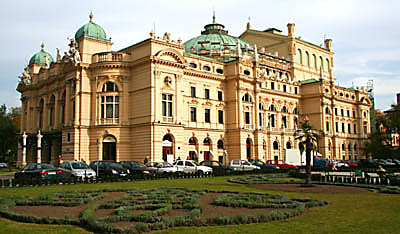|

Krakow's
Juliusz Slowacki Theater
In 1893 Krakow
acquired the brand-new theater building at 1 Plac Sw. Ducha
square and Szpitalna street to house its much envied company
of players.
The splendid
edifice of the city theater was modeled on the grand Paris
Opera. A vast Gothic complex of medieval hospital and
monastery together with its church of the Holy Spirit had
been demolished to make room for what was then a
state-of-the-art playhouse. The interior also was
impressive. Most of all the huge painted curtain with the
allegory of tragedy and comedy has gained enduring fame as
an outstanding work of art.
Krakow’s City
Theater, in 1908 renamed the Juliusz Slowacki Theater (Teatr
im. Juliusza Slowackiego), introduced to this country modern
stagecraft, drama, and acting at the turn of the 20th
century. Its thespians staged the most of important plays of
the period and endorsed the best Polish and foreign
playwrights. Among them was Stanislaw Wyspianski, Krakow’s
painter and poet of genius, who wrote all his milestone
dramas with this theater in mind on top of revolutionizing
the art of stage design.
Apart from its
primary theatrical function the Juliusz Slowacki Theater has
always served as an all-purpose public venue. It long
doubled as the Krakow opera house and occasionally
substituted for a congressional center.
The Teatr Slowackiego theater underwent a thorough
renovation
for its centennial in the early 1990s.

The
stunning curtain of Krakow's Teatr Slowackiego theatre was
designed by Henryk Siemiradzki in 1894.
Teatr Slowackiego Theater, one of Krakow's best companies
Teatr im. Juliusza Slowackiego is a well-known repertory
company in Poland. It boasts three auditoriums, i.e. Duza
Scena (Big Stage) in the main playhouse at 1 Plac Sw. Ducha
square, little Scena Miniatura in the adjacent building of
the former power station at 2 Plac Sw. Ducha square, and
still smaller Scena Brama (Gate Stage) at 4 Plac Sw. Ducha
square. The Slowacki Theatre stages Polish as well as
foreign plays in translation, both the classics and
contemporary drama: serious plays, comedies, and also
musicals. Its productions take place practically every day.
Contact info for the Teatr Juliusza Slowackiego theater
Postal address: Teatr im. Juliusza Slowackiego, Pl. Sw.
Ducha 1, 31-023 Krakow, Poland.
The Slowacki Theater has its booking office at
1 Sw. Ducha Pl. open from 10 a.m. to 2 p.m and between 2:30
p.m. and 6 p.m. on weekdays and Saturdays plus four hours
before the show on Sundays. Phone number for booking (+48)
124244525, phone/fax 124224022, email
bilet@slowacki.krakow.pl
Wawel Royal Castle
Home to three dynasties of Poland's monarchs. Its
stately halls and exquisite chambers are filled with priceless
art, best period furniture and rare ancient objects. The
collection of the 16th-century monumental Flemish
tapestries is matchless.
Wawel Cathedral
Poland's impressive national shrine shelters plenty of
superb church art. Its giant bell of 1520 ranks with the
world's largest. Most Polish kings and their family members are
buried in the cathedral, its chapels and crypts.
Grand Square
Krakow’s central Grand Square (Rynek Glowny), the
largest plaza of medieval Europe and one of the world’s finest
with its spectacular landmarks, has remained the hub of the city
since the 13th century.
Basilica of the Virgin Mary's
The immense Gothic church, Krakow's principal temple
since the 13th century, shelters the world's greatest Gothic sculpture among its many excellent works of art
Cloth Hall
The world's oldest shopping mall has been in business
for 700 years. The present Renaissance edifice dates from 1555.
Town Hall Tower
Krakow's leaning tower was built by the end of the 13th
century.
City Walls
700-year-old main city gate with adjoining mighty walls
and towers.
Planty Garden Ring
Park of 30 varied gardens among old trees round
Krakow's Old Town historical district
Collegium Maius
15th-century impressive Grand College of the Krakow
university where Copernicus once studied.
Krakow mummies
Picturesque 17th-century church and monastery shelter
numerous naturally mummified bodies in their crypts.
Kanonicza Street
The most beautiful of Europe's ancient streets,arguably
|




